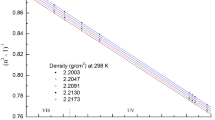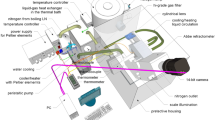Summary
The refractive index of zinc-blende increases appreciably on heating for all wavelengths in the visible region the increase being 0·0212 and 0.0107 respectively for wavelengths 4358 Å.U. and 7320 Å.U. on heating from 0° to 205° C. It is shown that by applying the general theory of Part I one can satisfactorily explain both the variation ofdn/dt with wavelength and the courses of the temperature—refractive index curves from −80° to 700° C. for different wavelengths. The calculations show that the ultra-violet dispersion frequency at 2532 Å.U. alters appreciably with temperature, the proportional rate of change χ=−d (log ν)/dt being 70×10−6. This is nearly ten times the corresponding rate for diamond. The rate of change becomes less and less on lowering the temperature. It is pointed out that, for diamond, χ actually vanishes at very low temperatures and this is also probably the case for zinc-blende.
Similar content being viewed by others
References
Coblentz, W. W.Carnegie Institution Publication, No. 65, 1906, 63.
Liebisch, Th.Physikalische Kristallographie, Leipzig, 1891, 92.
Mell, M.Zeits. f. Phys., 1923,16, 244.
Ramachandran, G. N.,Proc. Ind. Acad. Sci., A, 1947a,25, 266; 1947b,25, 280.
Author information
Authors and Affiliations
Additional information
(Communicated by Sir. C. V. Raman,kt.,f.r.s., n.l.)
Rights and permissions
About this article
Cite this article
Ramachandran, G.N. Thermo-optic behaviour of solids. Proc. Indian Acad. Sci. (Math. Sci.) 25, 375 (1947). https://doi.org/10.1007/BF03170772
Received:
DOI: https://doi.org/10.1007/BF03170772




